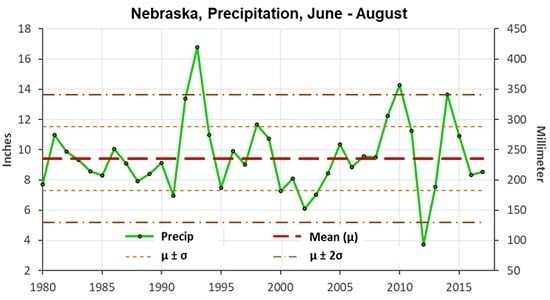Land Use Classification: A Surface Energy Balance and Vegetation Index Application to Map and Monitor Irrigated Lands
Abstract
:1. Introduction
2. Materials and Methods
2.1. Study Area
2.2. Datasets
2.3. Calibration Growing Season
2.4. Normal Difference Vegetation Index and Green Index
2.5. Surface Energy Balance System (SEBS)
2.6. Irrigation Indices Development
2.7. Thresholding
2.8. Performance Assessment
3. Results
3.1. NEG Classification Scheme and Groundtruth
3.2. Spatial Distribution of Irrigation
3.3. NEG Classification Scheme and NASS Statistics
4. Discussion
4.1. Dual Indices and Single Index
4.2. Seasonal Development of NGI and EGI
4.3. Application in Humid to Arid Climate Regimes, and Wet to Dry Growing Seasons
5. Conclusions
Acknowledgments
Author Contributions
Conflicts of Interest
Appendix A
| SCENE ID | SPACECRAFT ID | DATE | PATH | ROW |
|---|---|---|---|---|
| LE70310312010207EDC00 | Landsat 7 | 26 July 10 | 31 | 31 |
| LE70310312010239EDC00 | Landsat 7 | 27 July 10 | 31 | 31 |
| LE70310322010207EDC00 | Landsat 7 | 26 July 10 | 31 | 32 |
| LE70310322010239EDC00 | Landsat 7 | 27 July 10 | 31 | 32 |
| LT50310322010247EDC00 | Landsat 5 | 04 Sept 10 | 31 | 32 |
| LE70320312010230EDC00 | Landsat 7 | 18 Aug 10 | 32 | 31 |
| LT50320312010222PAC01 | Landsat 5 | 10 Aug 10 | 32 | 31 |
| LE70320312010246EDC00 | Landsat 7 | 03 Sept 10 | 32 | 31 |
| LE70320322010198EDC00 | Landsat 7 | 17 July 10 | 32 | 32 |
| LT50320322010222PAC01 | Landsat 5 | 10 Aug 10 | 32 | 32 |
| LE70320322010246EDC00 | Landsat 7 | 03 Sept 10 | 32 | 32 |
| LT50290312010217EDC00 | Landsat 7 | 05 Aug 10 | 29 | 31 |
| LT50290312010233EDC00 | Landsat 5 | 21 Aug 10 | 29 | 31 |
| LE70290322010177EDC00 | Landsat 7 | 26 June 10 | 29 | 32 |
| LT50290322010233EDC00 | Landsat 5 | 21 Aug 10 | 29 | 32 |
| LT50300312010208PAC01 | Landsat 5 | 27 July 10 | 30 | 31 |
| LT50300312010176EDC00 | Landsat 5 | 25 June 10 | 30 | 31 |
| LT50300322010208PAC01 | Landsat 5 | 27 July 10 | 30 | 32 |
| LT50300322010192EDC00 | Landsat 5 | 11 July 10 | 30 | 32 |
| LC80290312015199LGN00 | Landsat 8 | 18 July 15 | 29 | 31 |
| LE70290312015223EDC00 | Landsat 7 | 11 Aug 15 | 29 | 31 |
| LE70290312015255EDC00 | Landsat 7 | 12 Sept 15 | 29 | 31 |
| LC80290322015199LGN00 | Landsat 8 | 18 July 15 | 29 | 32 |
| LC80290322015215LGN00 | Landsat 8 | 03 Aug 15 | 29 | 32 |
| LE70300312015198EDC00 | Landsat 7 | 17 July 15 | 30 | 31 |
| LE70300312015214EDC00 | Landsat 7 | 02 Aug 15 | 30 | 31 |
| LC80300312015238LGN00 | Landsat 8 | 26 Aug 15 | 30 | 31 |
| LE70300322015198EDC00 | Landsat 7 | 17 July 15 | 30 | 32 |
| LE70300322015214EDC00 | Landsat 7 | 02 Aug 15 | 30 | 32 |
| LC80300322015238LGN00 | Landsat 8 | 26 Aug 15 | 30 | 32 |
| LC80310312015197LGN00 | Landsat 8 | 16 July 15 | 31 | 31 |
| LC80310312015245LGN00 | Landsat 8 | 02 Sept 15 | 31 | 31 |
| LC80310322015197LGN00 | Landsat 8 | 16 July 15 | 31 | 32 |
| LC80310322015213LGN00 | Landsat 8 | 01 Aug 15 | 31 | 32 |
| LC80310322015245LGN00 | Landsat 8 | 02 Sept 15 | 31 | 32 |
| LC80320312015204LGN00 | Landsat 8 | 23 July 15 | 32 | 31 |
| LC80320312015236LGN00 | Landsat 8 | 24 Aug 15 | 32 | 31 |
| LC80320322015204LGN00 | Landsat 8 | 23 July 15 | 32 | 32 |
| LC80320322015236LGN00 | Landsat 8 | 24 Aug 15 | 32 | 32 |
References
- Morrison, J.; Morikawa, M.; Murphy, M.; Schulte, P. Water Scarcity and Climate Change: Growing Risks for Businesses and Investors; A Ceres Report; Pacific Institute: Oakland, CA, USA, 2009. [Google Scholar]
- Ibrahim, A.M. The Nile Basin Cooperative Framework Agreement: The Beginning of the End of Egyptian Hydro-Political Hegemony. Mo. Environ. Law Policy Rev. 2011, 18. Available online: http://scholarship.law.missouri.edu/cgi/viewcontent.cgi?article=1395&context=jesl (accessed on 28 November 2017). [CrossRef]
- Nebraska Department of Natural Resources (NDNR). Annual Report and Plan of Work for the Nebraska State Water Planning and Review Process. Nebraska Department of Natural Resources. 15 September 2007. Available online: http://govdocs.nebraska.gov/epubs/N1500/A004-2007.pdf (accessed on 28 November 2017).
- Aiken, J.D. The Republican River: Negotiation, arbitration, and a federal water master. Cornhusker Econ. 2008, 382. Available online: http://digitalcommons.unl.edu/agecon_cornhusker/382/.
- Ozdogan, M.; Yang, Y.; Allez, G.; Cervantes, C. Remote sensing of irrigated agriculture: Opportunities and challenges. Remote Sens. 2010, 2, 2274–2304. [Google Scholar] [CrossRef]
- Alexandris, T.K.; Zalidis, G.C.; Silleos, N.G. Mapping irrigated area in Mediterranean basins using low cost satellite Earth Observation. Comput. Electr. Agric. 2008, 64, 93–103. [Google Scholar] [CrossRef]
- Wardlow, B.D.; Egbert, S.L. Large-area crop mapping using time-series MODIS 250 m NDVI data: An assessment for the U.S. Central Great Plains. Remote Sens. Environ. 2008, 112, 1096–1116. [Google Scholar] [CrossRef]
- Jin, N.; Ren, W.; Feng, M.; Sun, R.; He, L.; Zhuang, W.; Yu, Q. Mapping Irrigated and Rainfed Wheat Areas Using Multi-Temporal Satellite Data. Remote Sens. 2016, 8, 207. [Google Scholar] [CrossRef]
- Ambika, A.K.; Wardlow, B.; Mishra, V. Remotely sensed high resolution irrigated area mapping in India for 2000 to 2015. Sci. Data 2016, 3, 160118. [Google Scholar] [CrossRef] [PubMed]
- Pervez, M.S.; Brown, J.F. Mapping irrigated lands at 250-m scale by merging MODIS data and national agricultural statistics. Remote Sens. 2010, 2, 2388–2412. [Google Scholar] [CrossRef]
- Pervez, S.M.; Budde, M.; Rowland, J. Mapping irrigated areas in Afghanistan over the past decade using MODIS NDVI. Remote Sens. Environ. 2014, 149, 155–165. [Google Scholar] [CrossRef]
- Brown, J.F.; Pervez, M.S. Merging remote sensing data and national agricultural statistics to model change in irrigated agriculture. Agric. Syst. 2014, 127. [Google Scholar] [CrossRef]
- Gitelson, A.A.; Gritz, U.; Merzlyak, M.N. Relationships between leaf chlorophyll content and spectral reflectance and algorithms for non-destructive chlorophyll assessment in higher plant leaves. J. Plant Physiol. 2003, 160, 271–282. [Google Scholar] [CrossRef] [PubMed]
- Gitelson, A.A.; Vina, A.; Ciganda, V.; Rundquist, D.C.; Arkebauer, T.J. Remote estimation of canopy chlorophyll content in crops. Geophys. Res. Lett. 2005, 32, L08403. [Google Scholar] [CrossRef]
- Su, Z. The surface energy balance system (SEBS) for estimation of turbulent heat fluxes. Hydrol. Earth Syst. Sci. 2002, 6, 85–99. [Google Scholar] [CrossRef]
- Dappen, P.; Merchant, J.; Ratcliffe, I.; Robbins, C. Delineation of 2005 Land Use Patterns for the State of Nebraska Department of Natural Resources; Final Report; Center for Advanced Land Management Information Technologies (CALMIT): Lincoln, NE, USA, 2007. [Google Scholar]
- Szilagyi, J.; Jozsa, J. MODIS-Aided Statewide Net Groundwater-Recharge Estimation in Nebraska. Ground Water 2013, 51, 735–744. [Google Scholar] [CrossRef] [PubMed]
- Han, W.; Yang, Z.; Di, L.; Mueller, R. CropScape: A Web service based application for exploring and disseminating US conterminous geospatial cropland data products for decision support. Comput. Electron. Agric. 2012, 84, 111–123. [Google Scholar] [CrossRef]
- Riverside Technology, Inc. 2014 COHYST Ground Truth Data Collection for Use in Landcover Classification Task 1: Image Processing and Ground Truth Data Collection; Report; Cooperative Hydrology Study (COHYST): Lincoln, NE, USA, 2015. [Google Scholar]
- Goward, S.N.; Markham, B.; Dye, D.; Dulaney, W.; Yang, J. Normalized difference vegetation index measurements from the Advanced Very High Resolution Radiometer. Remote Sens. Environ. 1991, 35, 257–277. [Google Scholar] [CrossRef]
- DeFries, R.S.; Hansen, M.; Townshend, J.R.G.; Sohlberg, R. Global land cover classifications at 8 km spatial resolution: The use of training data derived from Landsat imagery in decision tree classifiers. Int. J. Remote Sens. 1998, 19, 3141–3168. [Google Scholar] [CrossRef]
- Mutiibwa, D.; Irmak, S. Estimation of crop coefficients from AVHRR-based NDVI for analyzing long-term trends in evapotranspiration in relation to changing climate in the USA High Plains. Water Resour. Res. 2012, 49, 231–244. [Google Scholar] [CrossRef]
- Ozdogan, M.; Gutman, G. A new methodology to map irrigated areas using multi-temporal MODIS and ancillary data: An application example in the continental US. Remote Sens. Environ. 2008, 112, 3520–3537. [Google Scholar] [CrossRef]
- Gitelson, A.A.; Viña, A.; Masek, J.G.; Verma, S.B.; Suyker, A.E. Synoptic monitoring of gross primary productivity of maize using Landsat data. IEEE Geosci. Remote Sens. Lett. 2008, 5, 2. [Google Scholar] [CrossRef]
- Huete, A.R.; Justice, C.O.; van Leeuwen, W.J.D. MODIS Vegetation Index, Algorithm Theoretical Basis Document. 30 April 1999; NASA Goddard Space Flight Centre: Greenbelt, MD, USA. Available online: http://gis-lab.info/docs/atbd_mod13.pdf (accessed on 28 November 2017).
- Gitelson, A.A. Wide dynamic range vegetation index for remote quantification of biophysical characteristics of vegetation. J. Plant Physiol. 2004, 161, 165–173. [Google Scholar] [CrossRef] [PubMed]
- Thomas, J.R.; Gaussman, H.W. Leaf reflectance vs. leaf chlorophyll and carotenoid concentration for eight crops. Agron. J. 1977, 69, 799–802. [Google Scholar] [CrossRef]
- Buschmann, C.; Nagel, E. In vivo spectroscopy and internal optics of leaves as basis for remote sensing of vegetation. Int. J. Remote Sens. 1993, 14, 711–722. [Google Scholar] [CrossRef]
- Gitelson, A.A.; Merzlyak, M.N. Quantitative estimation of chlorophyll a using reflectance spectra: Experiments with autumn chestnut and maple leaves. J. Photochem. Photobiol. B 1994, 22, 247–252. [Google Scholar] [CrossRef]
- Merzlyak, M.N.; Gitelson, A.A. Why and what for the leaves are yellow in autumn? On the interpretation of optical spectra of senescing leaves (Acer platanoides L.). J. Plant Physiol. 1995, 145, 315–320. [Google Scholar] [CrossRef]
- Su, Z.; Pelgrum, H.; Menenti, M. Aggregation effects of surface heterogeneity in land surface processes. Hydrol. Earth Syst. Sci. 1999, 3, 549–563. [Google Scholar] [CrossRef]
- Su, Z. A Surface Energy Balance System (SEBS) for estimation of turbulent heat fluxes from point to continental scale. In Advanced Earth Observation—Land Surface Climate; Su, Z., Jacobs, C., Eds.; Publications of the National Remote Sensing Board (BCRS): Delft, The Netherlands, 2001; USP-2, 01–02; p. 184. [Google Scholar]
- Samani, Z.; Bawazir, A.S.; Bleiweiss, M.; Skaggs, R.; Tran, V.D. Estimating daily net radiation overvegetation canopy through remote sensing and climatic data. J. Irrig. Drain. Eng. 2007, 133, 291–297. [Google Scholar] [CrossRef]
- Choudhury, B.J.; Idso, S.B.; Reginato, R.J. Analysis of an empirical model for soil heat flux under a growing wheat crop for estimating evaporation by an infrared-temperature based energy balance equation. Agric. For. Meteorol. 1987, 39, 283–297. [Google Scholar] [CrossRef]
- Monteith, J.L. Principles of Environmental Physics; Edward Arnold Press: London, UK, 1973; p. 241. [Google Scholar]
- Kustas, W.P.; Daughtry, C.S.T. Estimation of the soil heat flux/net radiation ratio from spectral data. Agric. For. Meteorol. 1989, 49, 205–223. [Google Scholar] [CrossRef]
- Press, W.H.; Teukolsky, S.A.; Vetterling, W.T.; Flannery, B.P. Numerical Recipes in C: The Art of Scientific Computing; Cambridge University Press: Cambridge, UK, 1997; 994p. [Google Scholar]
- Anderson, M.C.; Zolin, C.; Sentelhas, P.C.; Hain, C.R.; Semmens, K.; Tugrul Yilmaz, M.; Gao, F.; Otkin, J.A.; Tetrault, R. The Evaporative Stress Index as an indicator of agricultural drought in Brazil:an assessment based on crop yield impacts. Remote Sens. Environ. 2016, 174, 82–99. [Google Scholar] [CrossRef]
- Suyker, A.; Verma, B.S. Evapotranspiration of irrigated and rainfed maize–soybean cropping systems. Agric. For. Meteorol. 2009, 149, 443–452. [Google Scholar] [CrossRef]
- Daly, C.; Halbleib, M.; Smith, J.I.; Gibson, W.P.; Doggett, M.K.; Taylor, G.H.; Curtis, J.; Pasteris, P.A. Physiographically-sensitive mapping of temperature and precipitation across the conterminous United States. Int. J. Climatol. 2008, 28, 2031–2064. [Google Scholar] [CrossRef]
- Zhu, X.; Zhu, W.; Zhang, J.; Pan, Y. Mapping irrigated areas in China from remote sensing and statistical data. IEEE J. Sel. Top. Appl. Earth Obs. Remote Sens. 2014, 7, 4490–4504. [Google Scholar] [CrossRef]
- Ozdogan, M.; Salvucci, G.D.; Anderson, B.C. Examination of the Bouchet-Morton complementary relationship using a mesoscale climate model and observations under a progressive irrigation scenario. J. Hydrometeorol. 2006, 7, 235–251. [Google Scholar] [CrossRef]
- Kamthonkiat, D.; Honda, K.; Turral, H.; Tripathi, N.K.; Wuwongse, V. Discrimination of irrigated and rainfed rice in a tropical agricultural system using SPOT VEGETATION NDVI and rainfall data. Int. J. Remote Sens. 2005, 26, 2527–2547. [Google Scholar] [CrossRef]
- Peterson, D.; Whistler, J.; Egbert, S.; Brown, C.J. Mapping irrigated lands by crop type in Kansas. Pecora 18 Proc. 2011. [Google Scholar]
- Huete, A.R.; Didan, K.; Rodriguez, E.P.; Gao, X.; Ferreira, L.G. Overview of the radiometric and biophysical performance of the MODIS vegetation indices. Remote Sens. Environ. 2002, 83, 195–213. [Google Scholar] [CrossRef]
- Allen, R.G.; Pereira, L.S.; Raes, D.; Smith, M. Crop Evapotranspiration—Guidelines for Computing Crop Water Requirements—FAO Irrigation and Drainage Paper 56; Food and Agriculture Organization of the United Nations (FAO): Rome, Italy, 1998. [Google Scholar]
- Hergert, G.W.; Margheim, J.F.; Pavlistaa, A.D.; Martin, D.L.; Supallab, R.J.; Isbellc, T.A. Yield, irrigation response, and water productivity of deficit to fully irrigated spring canola. Agric. Water Manag. 2016, 168, 96–103. [Google Scholar] [CrossRef]
- Gowda, P.H.; Chavez, J.L.; Colaizzi, P.D.; Evett, S.R.; Howell, T.A.; Tolk, J.A. ET Mapping for Agricultural Water Management: Present Status and Challenges. Irrig. Sci. 2008, 26, 223–237. [Google Scholar] [CrossRef]
- Lillesand, T.M.; Kiefer, R.W. Remote Sensing and Image Interpretation; John Wiley & Sons: New York, NY, USA, 2000; p. 736. [Google Scholar]
- Mutiibwa, D.; Vavrus, S.J.; McAfee, S.A.; Albright, T.P. Recent spatiotemporal patterns in temperature extremes across conterminous United States. J. Geophys. Res. Atmos. 2015, 120. [Google Scholar] [CrossRef]
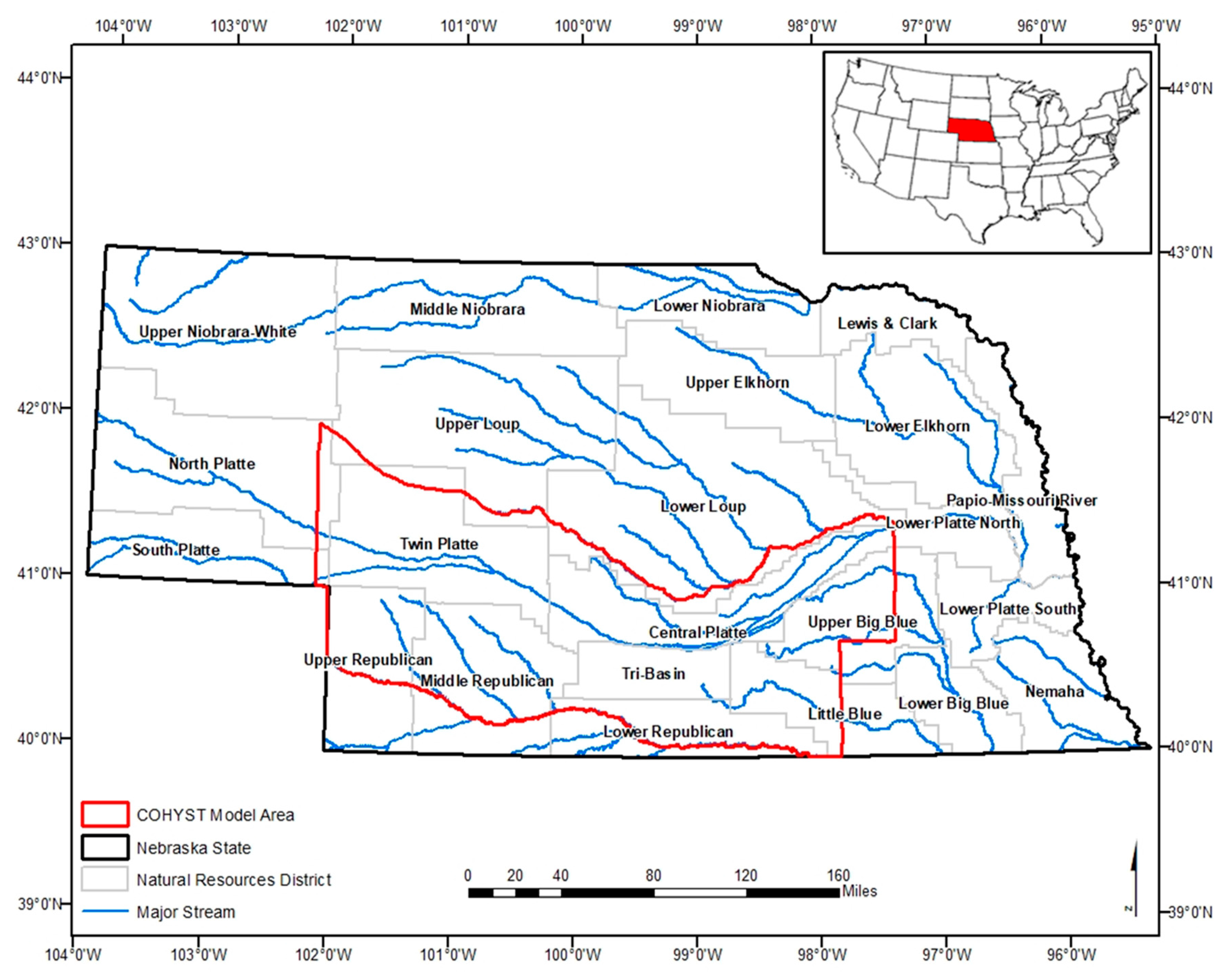
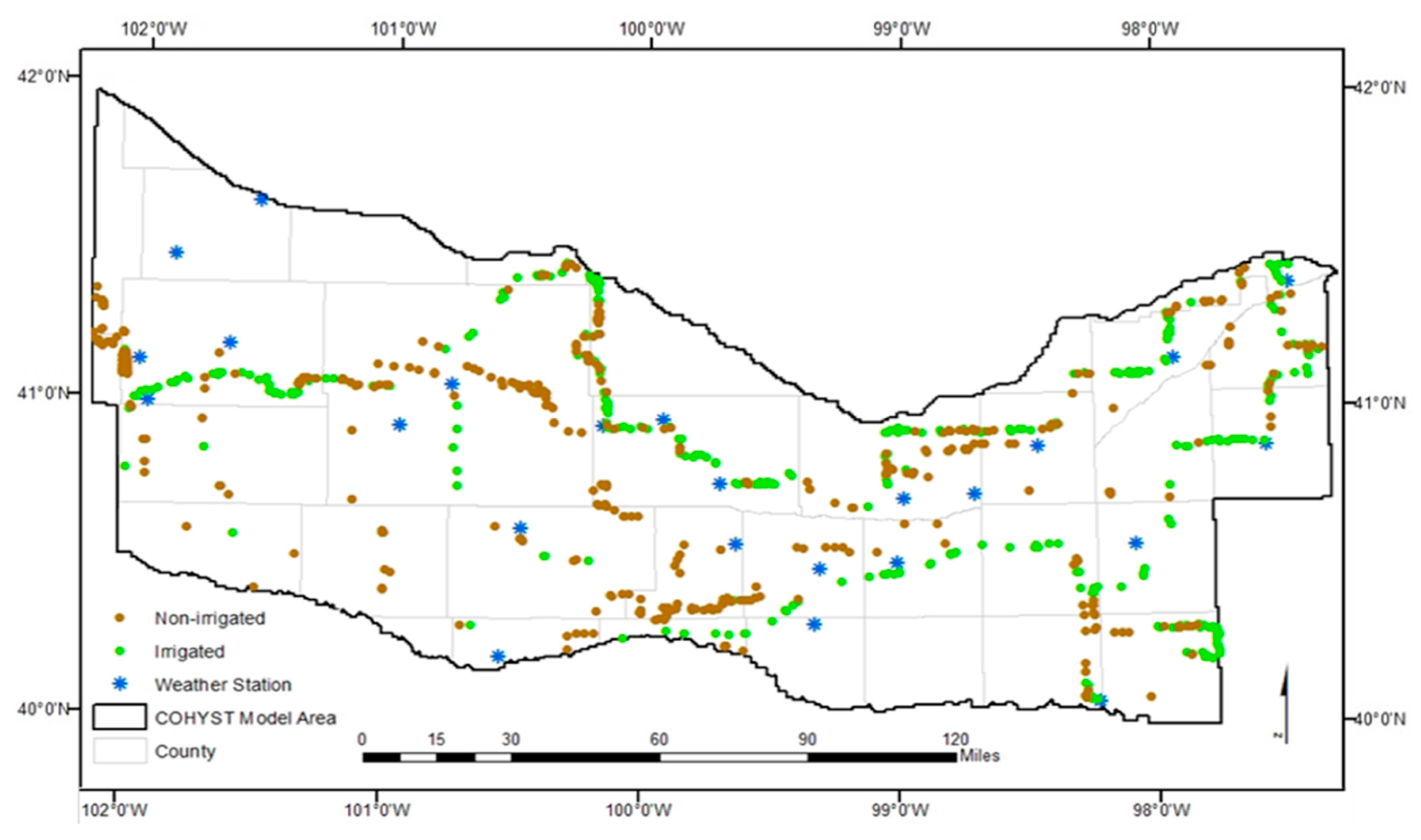
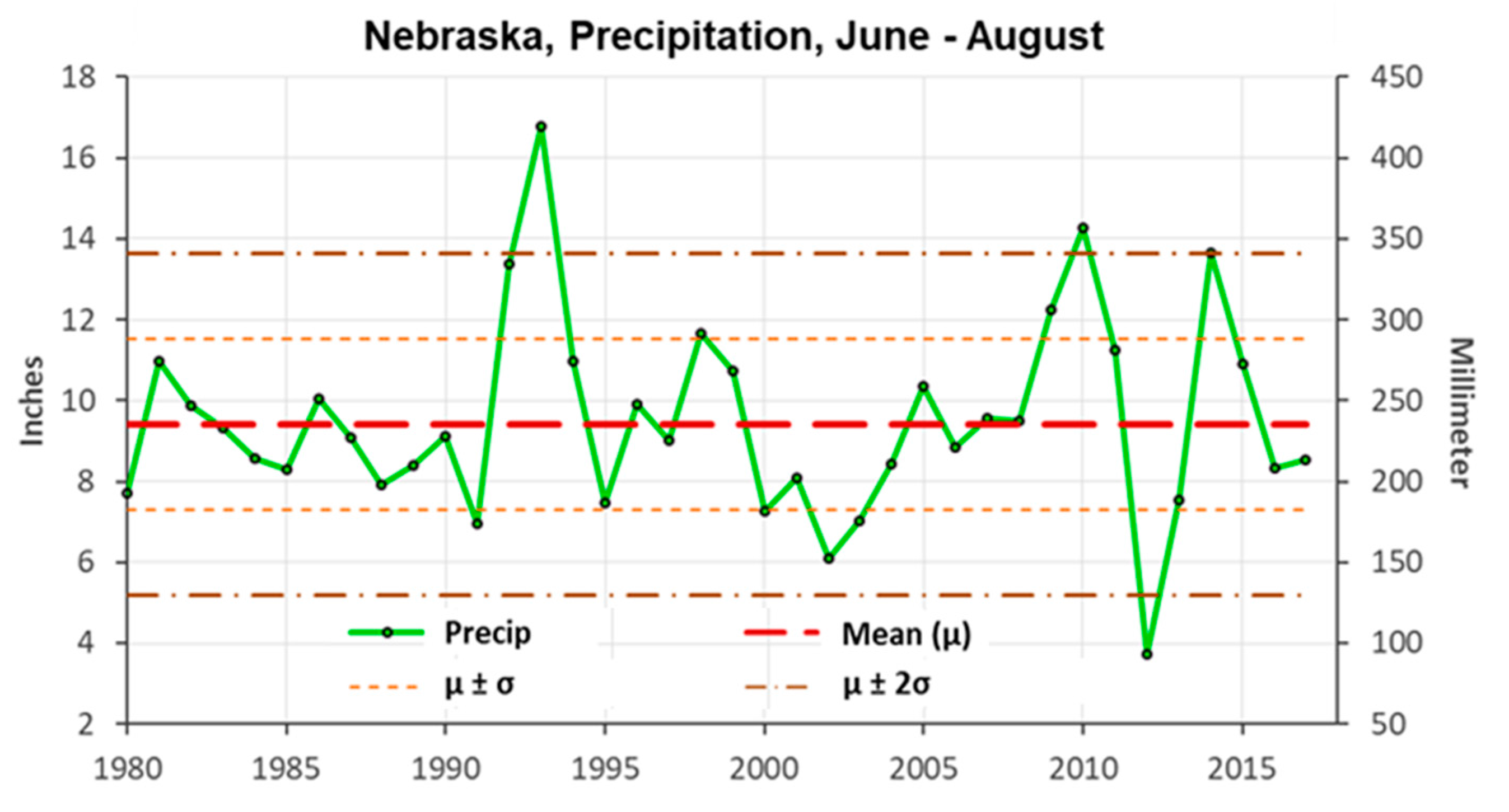
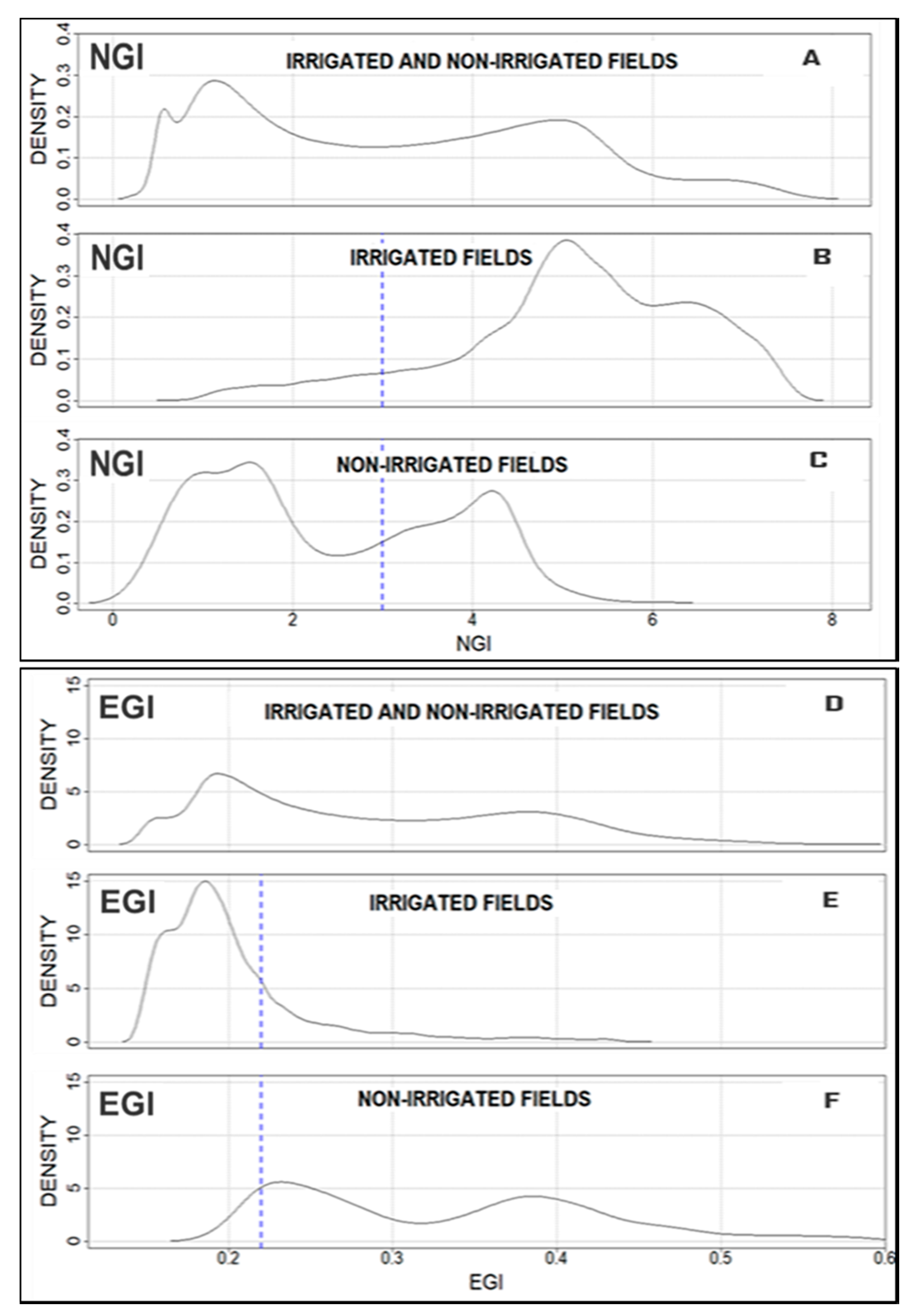
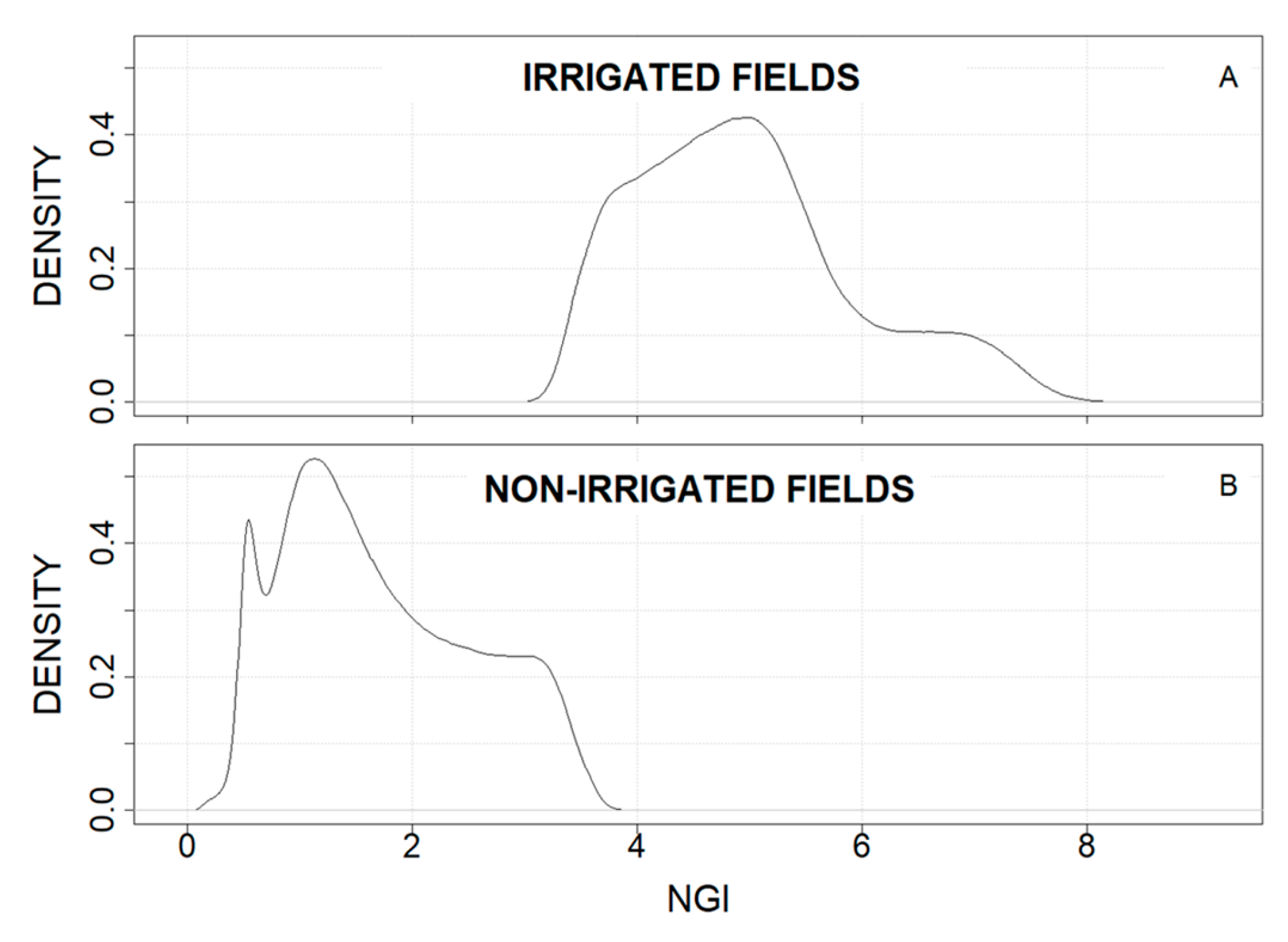
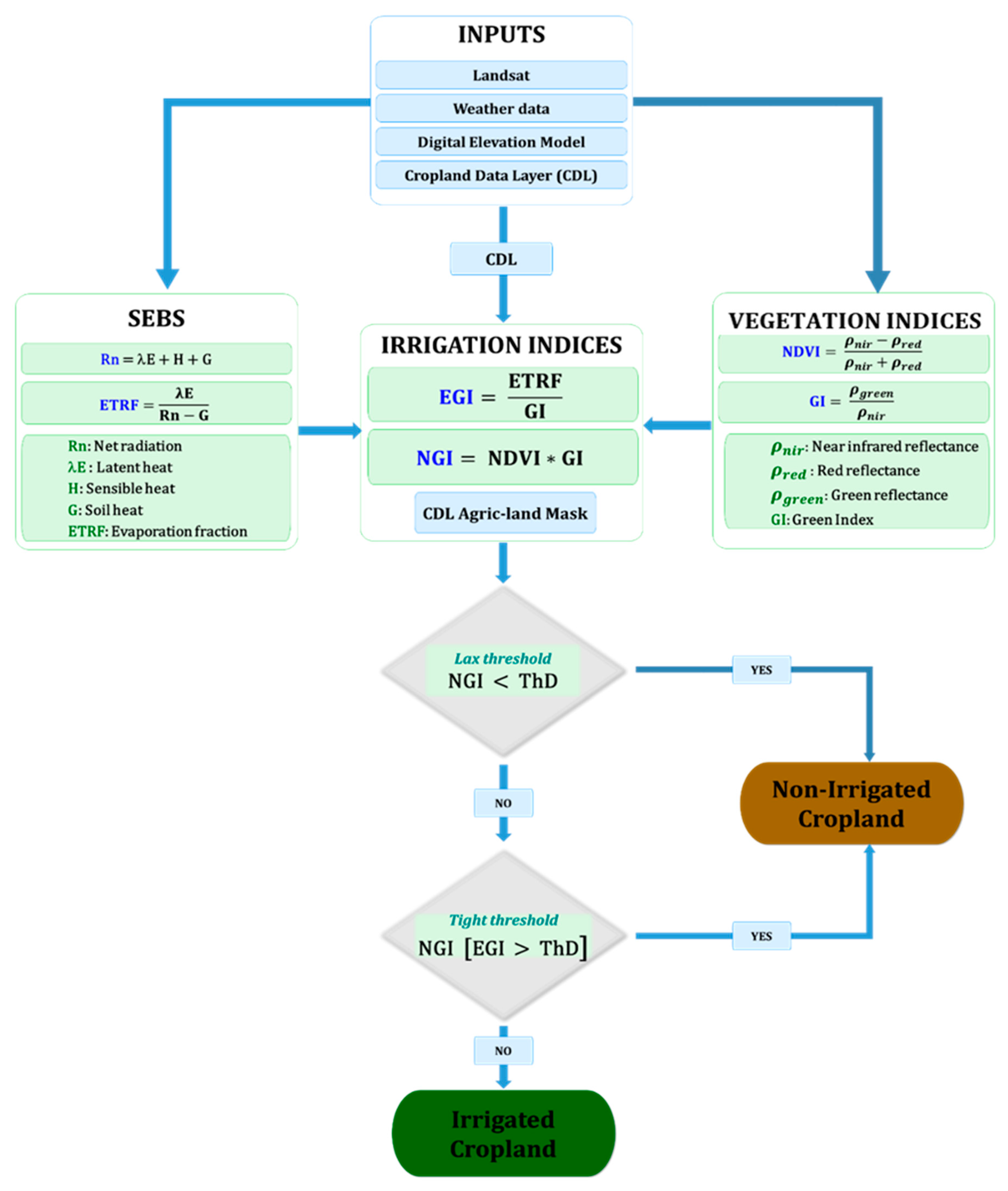
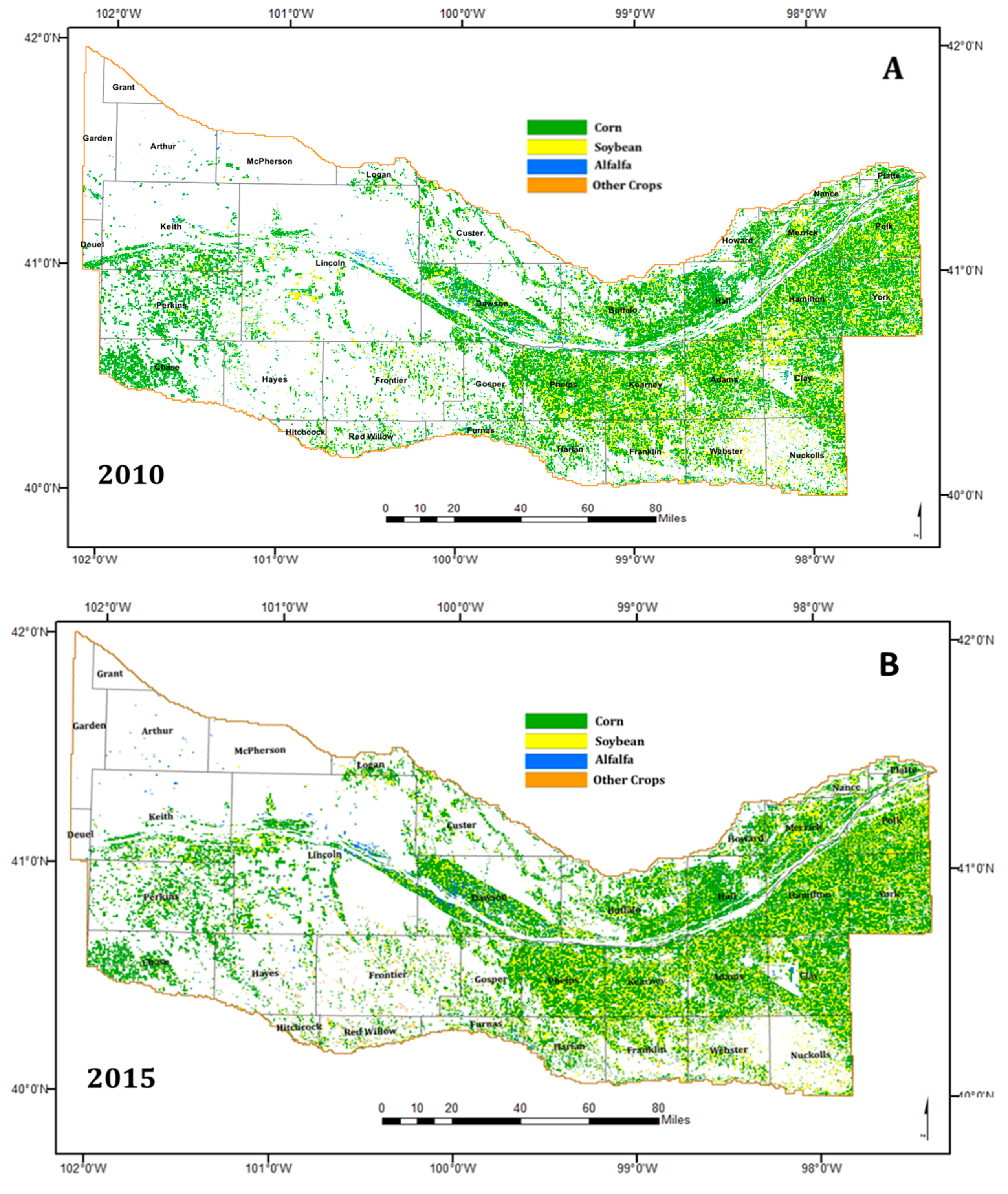
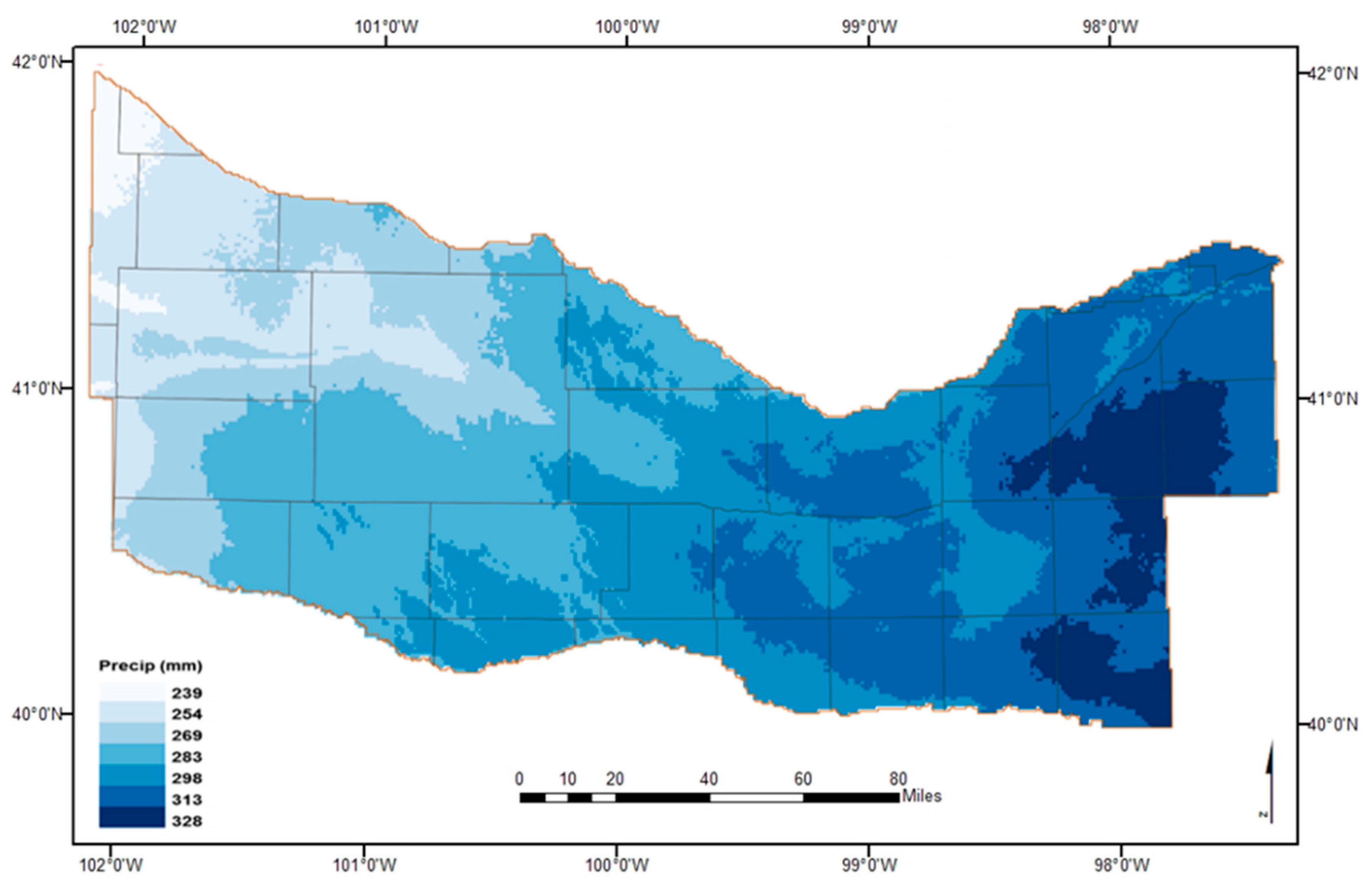


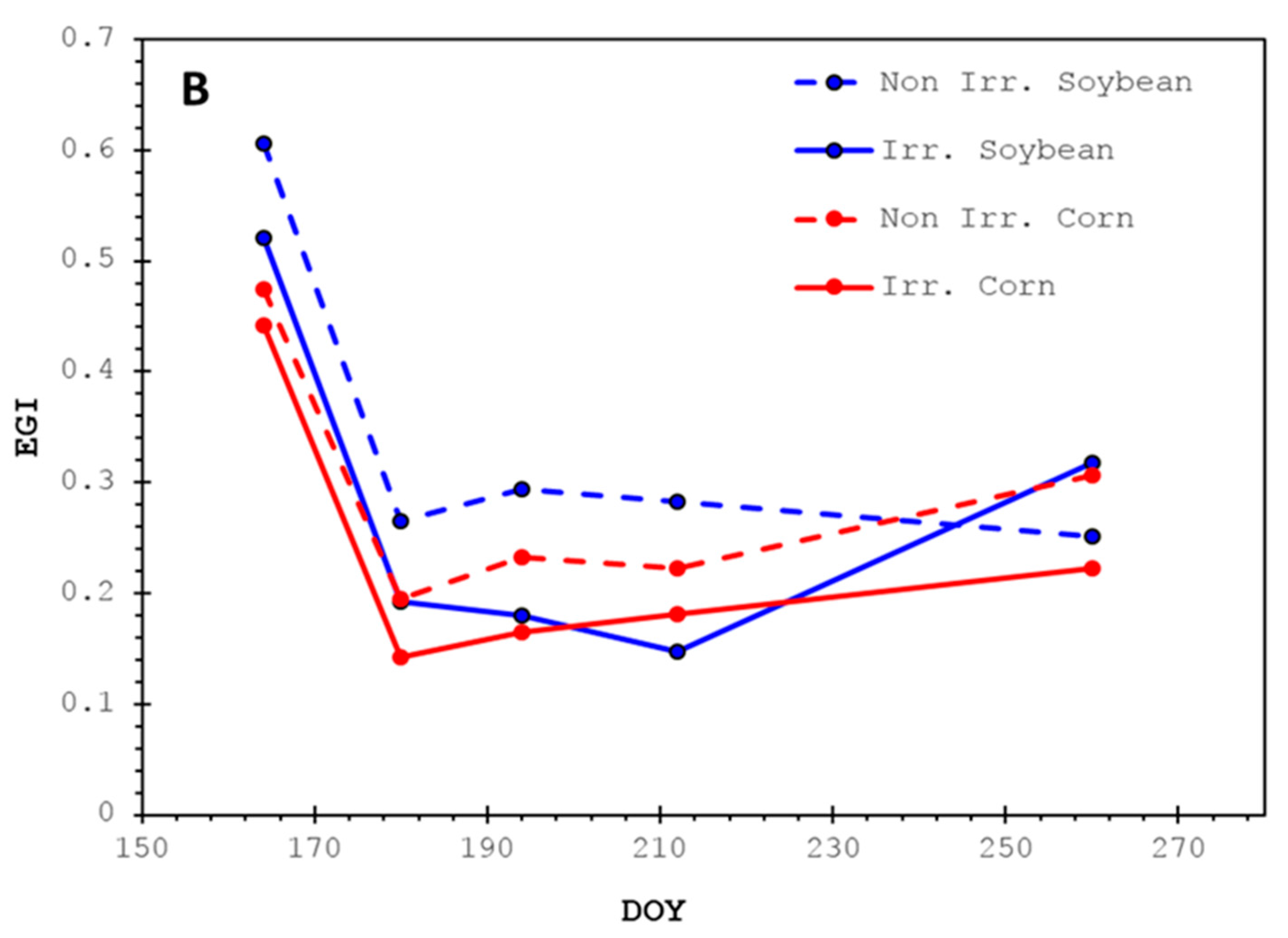
| Year | Irrigation Status | Producer’s Accuracy (%) | User’s Accuracy (%) | Overall Accuracy (%) | Kappa Value |
|---|---|---|---|---|---|
| 2010 | Irrigated | 90 | 92 | 87 | 0.70 |
| Non-irrigated | 81 | 77 | |||
| 2014 | Irrigated | 98 | 88 | 91 | 0.82 |
| Non-irrigated | 83 | 96 | |||
| 2015 | Irrigated | 93 | 71 | 88 | 0.72 |
| Non-irrigated | 86 | 97 |
| Crop | 2010 | 2015 | ||
|---|---|---|---|---|
| Area (ha) | % Area | Area (ha) | % Area | |
| Corn | 979,246 | 67.0 | 1,093,569 | 68.0 |
| Soybean | 446,856 | 30.6 | 456,255 | 28.0 |
| Alfalfa | 35,902 | 2.5 | 34,665 | 2.1 |
| STATS | 2015 | 2010 |
|---|---|---|
| R2 | 0.99 | 0.98 |
| MAPE (%) | 7.48 | 6.30 |
| RMSE (ha) | 6829.40 | 4625.00 |
© 2017 by the authors. Licensee MDPI, Basel, Switzerland. This article is an open access article distributed under the terms and conditions of the Creative Commons Attribution (CC BY) license (http://creativecommons.org/licenses/by/4.0/).
Share and Cite
Pun, M.; Mutiibwa, D.; Li, R. Land Use Classification: A Surface Energy Balance and Vegetation Index Application to Map and Monitor Irrigated Lands. Remote Sens. 2017, 9, 1256. https://doi.org/10.3390/rs9121256
Pun M, Mutiibwa D, Li R. Land Use Classification: A Surface Energy Balance and Vegetation Index Application to Map and Monitor Irrigated Lands. Remote Sensing. 2017; 9(12):1256. https://doi.org/10.3390/rs9121256
Chicago/Turabian StylePun, Mahesh, Denis Mutiibwa, and Ruopu Li. 2017. "Land Use Classification: A Surface Energy Balance and Vegetation Index Application to Map and Monitor Irrigated Lands" Remote Sensing 9, no. 12: 1256. https://doi.org/10.3390/rs9121256




